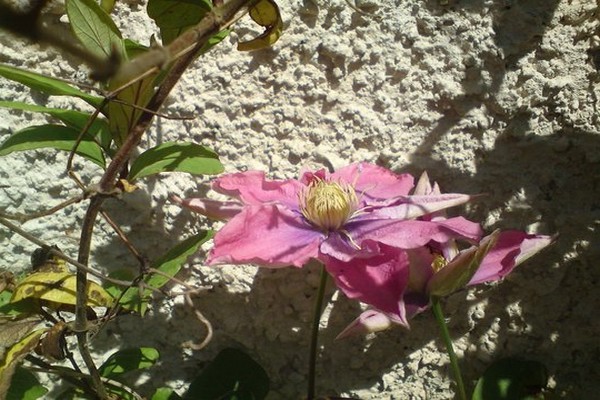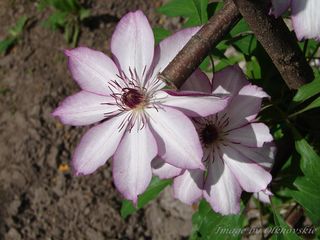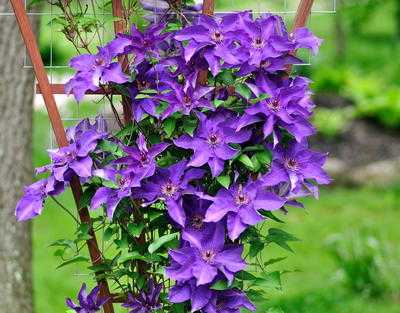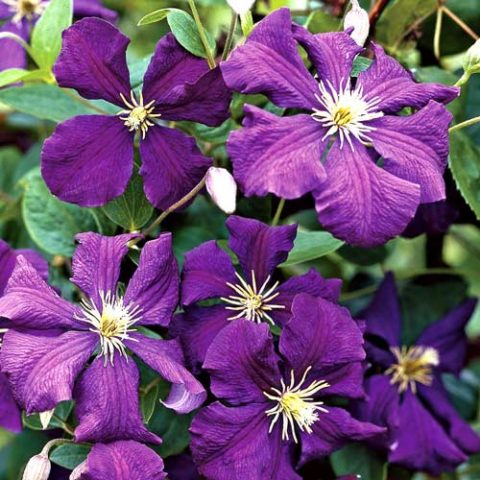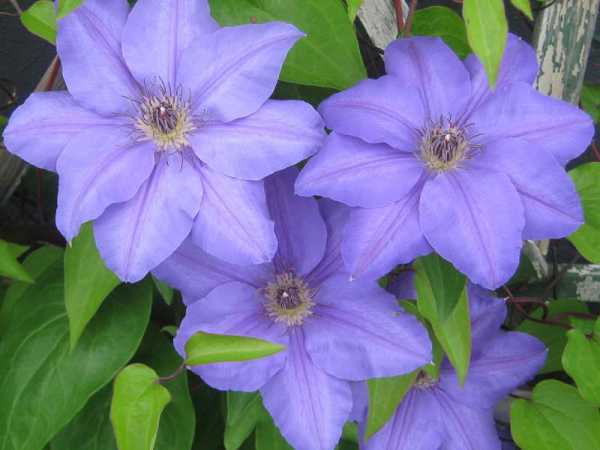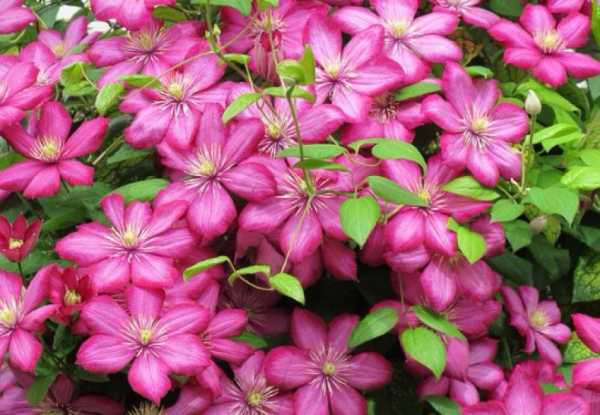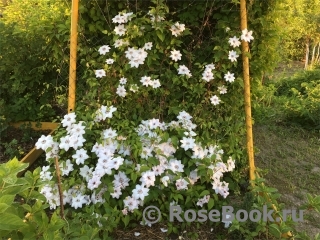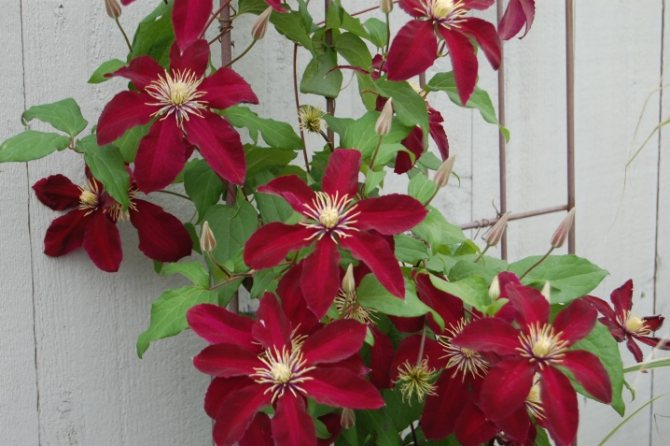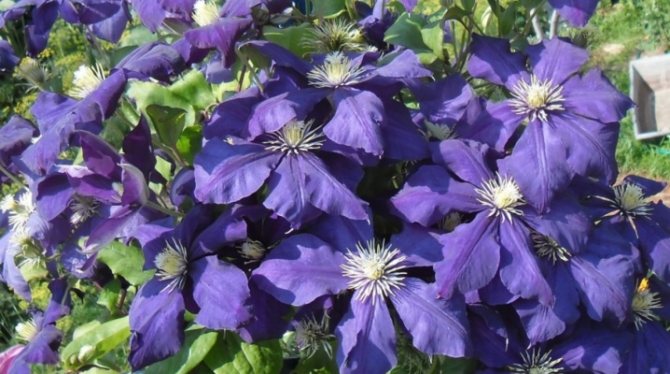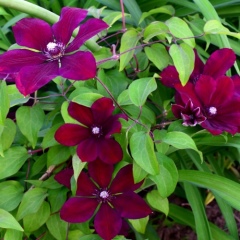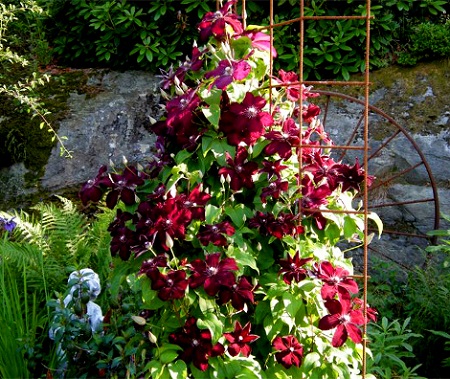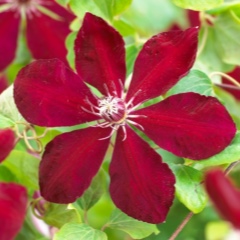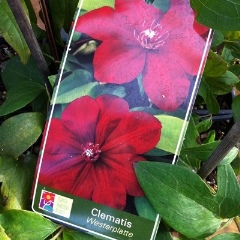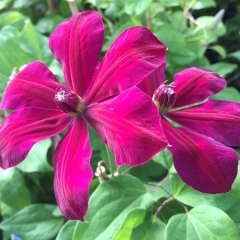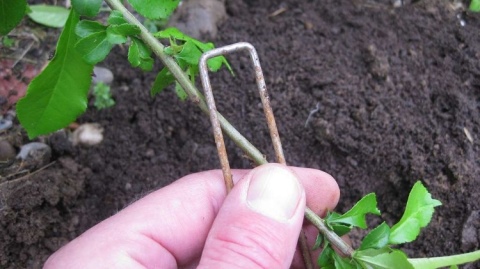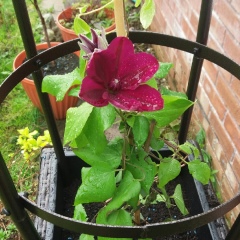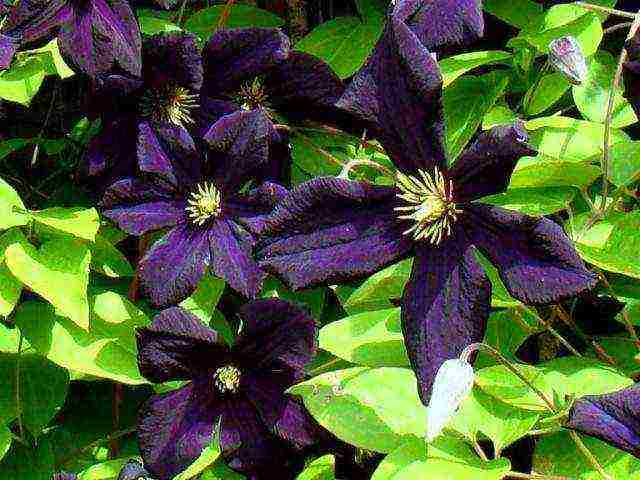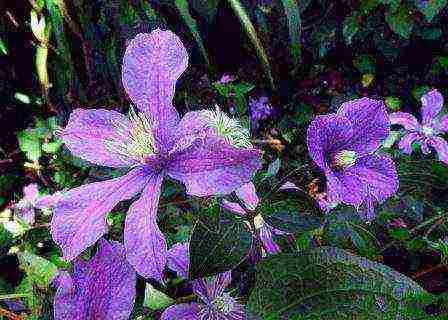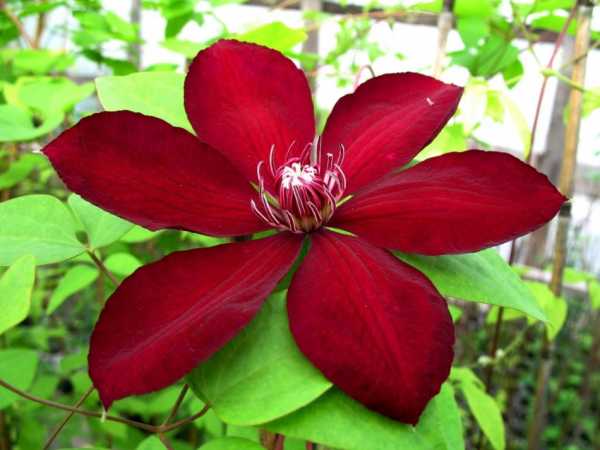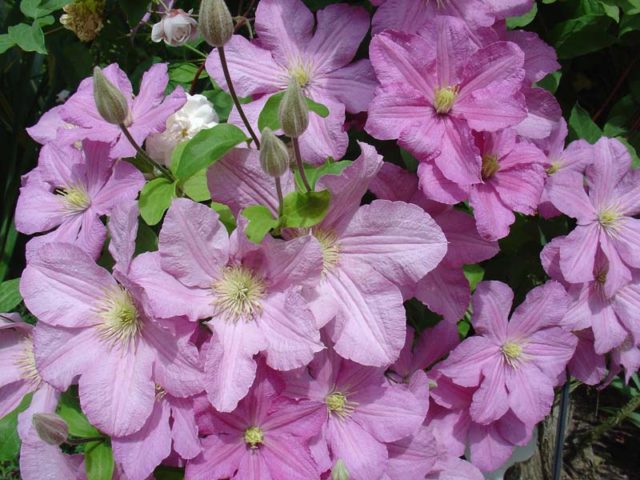International classification by trimming groups
Another generally accepted classification of clematis is associated with the peculiarities of their pruning. According to this indicator, three groups are distinguished: first, second, third.
The first one is without cropping
This subgroup includes clematis, which bloom in late spring or early summer (only on last year's shoots). They don't need pruning in the fall. Therefore, it is enough to remove all wilted inflorescences, as well as diseased and damaged branches. Usually varieties from the first group are frost-resistant. They do not need to be covered for the winter.
Cecile
Cecil is a winter-hardy variety of clematis with blue inflorescences 5-6 cm in diameter. In the south, flowering begins in April, in other regions - in mid-May. The buds are formed in large numbers.
Cecile shoots reach 3 m in length
Columella
Columella is a frost-resistant variety. The buds appear early: in April and May. The plant reaches 3 m in length.
Columella forms bell-shaped inflorescences that look very graceful
Frances Rivis
Francis (Franchez) Reeves is an early flowering clematis that gives small (up to 6 cm) inflorescences of blue color with purple hues. The variety can be grown in different regions of Russia, while it is quite rare on sale.
Francis Reeves' bright, blue-petaled, yellow-stamen inflorescences appear from April to June
Constance
Constance is a variety of lilac-pink clematis. Inflorescences up to 6 cm in diameter, height up to 2 m.
Constance blooms at the end of April, a second wave begins in July
The second is weak
Clematis belonging to the second group are pruned twice: after flowering (only last year's shoots with wilted peduncles are removed) and in mid-autumn, after the onset of the first frost (complete removal of weak branches and shortening the rest by a third of the length). They bloom on the shoots of the past and current seasons.
Andromeda
The clematis variety Andromeda produces large white inflorescences with a lilac strip in the middle and yellow stamens. The buds appear in June, with a second wave in August. Growing at a moderate pace. Prefers places with light partial shade. Perfectly winds through shrubs and trees.
Andromeda's flowers are very large - up to 20 cm in diameter
Westerplatte
Westerplatte is a variety with bright red inflorescences. Their diameter reaches 14 cm.
Westerplatte buds appear in large numbers from mid-July to late September
Blue Angel (Blekitny Aniol, Blue Angel)
Polish variety with medium-sized bluish-yellow inflorescences - 10–12 cm wide. Blooms profusely. Petals (4 pcs.) Depart from each other at a short distance, wavy edges. Can be grown in containers on a balcony or terrace.
Blue Angel is used to decorate gazebos and vertical structures.
H. F. Young
The variety gives dark blue, lilac inflorescences. Liana grows up to 3.5 m. The first buds open in mid-May, flowers are semi-double or single. Decorates vertical structures, shrubs. Can be planted on a balcony or terrace.
The flowers of the H.F. Young variety are very large, up to 22 cm in diameter
Hania
A hybrid variety of Chania originated in Poland. The flowers are large, up to 15 cm wide. The color is deep pink, the stamens are light yellow.
Chania's Scourge grows up to 2.5m
The third is strong
These clematis bloom only on young shoots of the current year. Therefore, they need radical autumn pruning. At the beginning of October, all branches are removed, leaving 2–3 nodes; 1-2 internodes. Then they completely fall asleep with foliage or other mulch (in the south this can be omitted). In early spring, the layer is removed so that the plants do not overheat.
Lady Betty Belfort (Lady Betty Balfour)
A hybrid variety with the romantic name Lady Betty Belfort was bred in England. Produces very beautiful blue-violet inflorescences with a diameter of 13-18 cm. If planted in an open area, it will grow rapidly.
Shoots at Lady Betty Belfort are 4 m long
Pink Fantasy
The Pink Fantasy variety gives pleasant, delicate inflorescences up to 15 cm in diameter with a different number of petals - from 5 to 7.Flowering lasts from July to early September.
Pink Fantasy bush is compact, therefore suitable for growing in containers
Reiman
One of the best varieties of lilac clematis. Inflorescences are six-petalled, rich in color, very large (17–20 cm).
The buds of the Reiman variety appear from mid-July to the first frost.
Clematis Jackmanii
Clematis Zhakmana is a spectacular flower of various colors: from white to rich lilac. Inflorescences up to 15 cm wide.
Lianas in the Zhakman variety up to 5 m long, twist well along vertical supports
Landing rules
First you need to choose a seedling. First of all, you need to look at its vines and leaves. They must be in good condition and free from any damage or stains. In the spring, the buds should be seen quite clearly. The seedlings can be sold in small pots or straight from the open field. It is best to wrap the root system of the latter with a slightly damp cloth during transportation.
The selected land should be fairly fertile and loose, and be able to absorb excess moisture. Sandy or loamy soil is most suitable, but acidic soils are best avoided. If everything is done correctly, then such a plant will delight everyone with its unusual appearance for a long time. Preparing the pit must be done in advance - 14-16 days before. Its width and depth should be at least 60 centimeters. In addition, the bottom must be covered with a drainage layer made of broken brick, small stones or slate. Then you can lay out a layer of humus. All this must be carefully trampled down.
You can add additional fertilizers to the pit, such as some ash, chalk or peat. But in this case, the hole must be dug a little earlier - 25-30 days before the start of disembarkation. In addition, several supports must be installed in it, on which clematis vines can be located in the future. Their length should be up to 2 meters. The distance between young seedlings of this plant should not exceed one and a half meters. This will allow the bush to develop fully.
Clematis can be planted in any season: in spring, summer, and autumn. However, the first month of autumn is considered the optimal time. The root system must be dried a little, and then soaked for 2 hours in plain water. It is necessary to plant seedlings in the prepared hole. Their roots must be well leveled, and the lowest bud should be deepened 7 centimeters into the ground. This will contribute to the emergence of a large number of shoots in the future.
Clematis Comtesse de Bouchaud: characteristics of an unpretentious variety
Clematis is a luxurious garden decoration. Liana fits nicely into landscape design.
The history of the emergence and features of the Comtesse de Boucher variety
The variety is suitable for growing both experienced and novice gardeners. Positive reviews about Clematis Comtesse de Bouchaud are due to the attractive features of the plant. The flower is resistant to low temperatures and disease. The variety is unpretentious and undemanding to care for.
The variety gained popularity as a large-flowered liana with voluminous pink buds. The variety was obtained by crossing. The resulting description clematis de comtesse Boucher allows you to indicate the unique decorative properties of the plant.
- rich and colorful color of flowers in the pink-lilac spectrum;
- the height of the culture is about 2.5-3 meters;
- long and abundant flowering, which lasts from early summer to September;
- the diameter of the inflorescences is from 10 to 15 cm.
The plant belongs to the fourth group of winter hardiness, which indicates the ability to withstand frosts down to -35 degrees. Many gardeners are interested in what group of pruning clematis Comtesse de Bouchot and what are the other features of the culture. The cultivar is included in the third "block", which is considered to be strong. In addition, it is a richly flowering and healthy species. But it should be borne in mind that the plant develops for a long time.You can find out how to grow clematis from seeds here.
What is the difference between the clematis variety?
Among other features of this variety of clematis, it is worth noting some of the nuances of flower formation. The edges of the petals curl slightly downward, which creates an attractive roundness. They usually have 6 sepals. Their contours are wavy. Flowers on a plant are usually arranged in 3 pieces. Most of them are formed in the upper part of the bush. Clematis also has anthers of a light yellow hue.
Through culture, there is a chance to exquisitely decorate:
Even the most boring and inexpressive area on the territory will be transformed and sparkle with new colors. The variety is similar in structure to grapes.
That is why it is so important to leave enough free space for it for full growth and placement. According to gardeners, the lashes of Comtessede Bouchaud are easily guided in the right directions, and there are no problems with the distribution of the flower.
The variety grows rather slowly, but with proper care it can decorate the garden for up to 20 years.
The subtleties of planting culture
Before planting, you need to remember that the plant is not planted for one season, but for several years.
After half an hour, you can plant a bush. From above it is sprinkled with earth
It is equally important to lightly irrigate the soil with warm water. It is worth completing the flower planting procedure by forming a layer of mulch.
The nuances of propagation by cuttings and seeds
The most convenient breeding method is cuttings.
You can also use layering, but clematis seed propagation at home will be more effective. Stratification is recommended to achieve good results. For this, the seed is immersed in a soil mixture consisting of earth, sand and peat. It must be kept at a temperature of within +5 degrees. The refrigerator will be the best place for the procedure. This preparation provides a high germination rate.
A little about the care of clematis Comtesse de Bouchot
Clematis is trimmed in groups, and this variety is processed according to the second type.
Comtessede Bouchaud is unpretentious to the composition of the soil. Watering this flower needs moderate. The main thing is to prevent rainwater from getting on the crop. It is recommended to form a thick layer of mulch around the root system. It will protect the plant from freezing. Despite the capriciousness of other varieties of this culture, clematis diseases and their treatment are not a problem in this case. Comtesse de Bouchot is resistant to most ailments.
Landing rules
“Arabella” is referred to as clematis for beginners, as it “forgives” its owners for minor oversights, to which more expensive varieties will react with a sharp deterioration in their decorative effect. Correctly planted this plant will be a key factor in the abundant flowering and longevity of the bush.
Like all other representatives of this culture, "Arabella" prefers sunny places, although in light partial shade the plant can thrive. Due to the peculiarities of growth, this flower can be planted next to a vertical support or as an ampelous plant in a flowerpot, but in any case, it will need good drainage to prevent stagnation of water. It is no secret that excess moisture often causes problems with clematis and even leads to their rapid death.

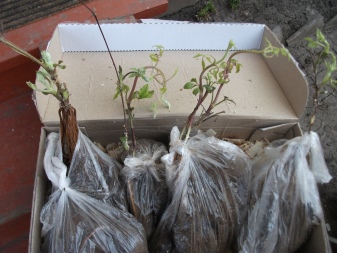
Plants with an open root system should be planted in late spring or early fall. In the first 3-4 weeks after planting, the plant will need light darkening and maintenance of the soil in a moist state until final rooting.
You should not buy seedlings with whitish elongated shoots - they will become ill and most likely will not take root.
Seedlings with a closed root system and juicy green shoots can only be selected if you can plant them within 7-10 days.
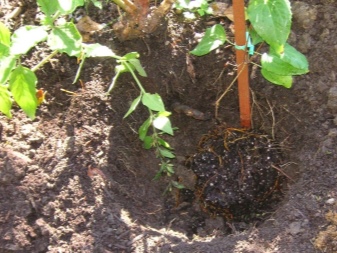

Arabella can grow on all types of soil. It should not have stagnant moisture, but it should have the necessary nutrients. At the bottom of the prepared planting pit, it is necessary to lay out expanded clay, crushed stone or pebbles with a layer of 15-25 cm, and then cover it with earth with the addition of wood ash, as well as humus and superphosphate.
If you grow clematis in a pots, a drainage layer is also required, but it may be less - 7-12 cm. As a substrate, you can use ordinary garden soil mixed with humus. Keep in mind that even in the most voluminous hanging pots, clematis cannot live longer than 3-4 years, sooner or later you will have to transplant it into the ground or divide it.
When planting a seedling, it is important that the root collar is 5-10 cm deep.In cold regions, a flower will additionally require a thick layer of organic mulch
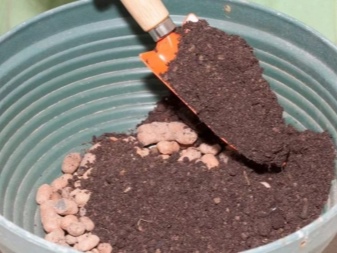
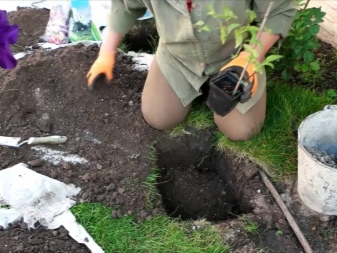
Description
The variety of clematis Purpurea Pleinas Elegance cannot be called completely new - it was obtained at the very turn of the century more than 100 years ago in France. According to some sources, its author is the famous breeder F. Morel, according to others - E. André. Despite its considerable age, the variety has not yet lost its popularity and is one of the most widespread and sold clematis in the whole world. This clematis was even honored with the highest award of the Royal Garden Society.
One of the names under which it is sometimes found on sale - Royal Velvet or Royal Velvet, can cause some confusion among flower growers. Since the clematis variety "Evifour" is sometimes sold under the same name. And they named it that for the amazing, almost velvety texture of the flower petals, although some gardeners claim that it disappears by the end of summer and the flowers become simply beautiful.
Clematis Purpurea Pleinas Elegance belongs to the Viticella group, which in turn belongs to the third pruning group. Flowers appear mainly on the shoots of this year.
Liana has an average growth energy and in especially favorable conditions can reach 4 meters, although in Russian conditions its shoots usually grow up to 2.5 - 3.5 meters.

Flowers and buds mostly look up and to the sides. The uniqueness of this variety of clematis is the fact that all the flowers that form on it are double. And the absence of pistils and stamens leads to a rather unusual appearance of flowers, which differs from many other varieties. In addition, among the clematis of the 3rd pruning group, that is, those that manage to form flowers on young shoots of the current year, you will practically not find double varieties. This is the privilege of clematis of the 2nd pruning group, in which similar flowers are laid on last year's, uncut shoots.
The flowers cannot boast of large sizes, they grow only up to 5-8 cm in diameter, but they are formed in such abundance that they can form a real blooming wall.
Comment! Each shoot of Clematis Purpurea Pleinas Elegance can form up to 150 double flowers.
Their color is also somewhat unique. It is difficult to describe it unambiguously in words. At the moment of opening, the flowers of clematis are distinguished by a rich deep dark red hue, which over time not only slightly fades in the sun, but changes and becomes reddish-purple with a purple tint. The color shade of clematis can also be determined by the composition of the soil and the level of illumination.
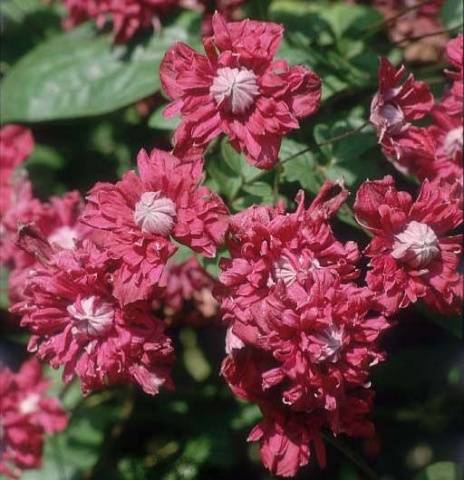
Finally, the very flowering of clematis of this variety can begin already at the end of June and is so long that it lasts until September inclusive. Perhaps it is difficult to imagine any other kind of clematis that would bloom so abundantly and for a long time, and even with double flowers.It is for this that Clematis Purpurea Plenas Elegance is a favorite with many flower growers.
But this is not all the advantages of the hero of the article. The frost resistance of this variety is also admirable - it can withstand frosts down to -40 ° C and it is grown without problems even in the harsh conditions of Western and Eastern Siberia.
In addition, the choice of lighting for growing Clematis Purpurea Pleinas Elegance is also quite large. He will not be able to grow only at the northern walls, all the other expositions are quite suitable for him. For him, even areas with light penumbra are suitable. When planted in such places, flowering will only begin a few weeks later, otherwise it will be as abundant and luxurious as in the sun.
Yes, and as for resistance to diseases and adverse conditions in general, this type of clematis rarely has any problems, especially if it is planted correctly and the basic rules for its cultivation are followed.
Attention! Do not expect abundant flowering from this clematis variety the next year after planting. He needs to take root and build up the root system, and then he will show himself in all its glory

But later he is able to grow a huge number of stems and leaves, and then flowers, almost from scratch in one warm season.
Choosing varieties
In order to enjoy the flowering of clematis to the fullest, you need to choose the right variety, in accordance with the climatic conditions of the area in which they will grow.
In addition, the wrong variety may not take root at all in your garden.
About clematis for the Urals zone
Zhakman
The Zhakmana clematis group is a group of large-flowered bush lianas. Their distinctive feature is a powerful root system and long lashes reaching 4m. The leaves are lanceolate, and the flower circumference reaches 20cm. In most cases, the flowers of this group of clematis have a lilac color of the petals.
The most promising varieties of this subgroup are Rouge Cardinal, Bella, Star of India.
Integrifolia
Clematis of this group have not too long shoots, up to 2.5 m in length, as well as medium-sized bell-shaped flowers reaching 12 cm in circumference.
The best representatives of this group are Mrs Cholmondeley and Purpurea Plena Elegans.
Vinzella
Shoots of these clematis reach 3.5 meters in size. The flowers are not the largest, up to 12cm in circumference, but there can be up to 100 of them on the bush. Flowers in the Vinzella subgroup are usually red, pink, sometimes purple. And the leaves have a very intricate, memorable shape.
Such varieties of this group as Ville de Lyon, Prince Charles, Ernest Markham are most suitable for cultivation in the Urals.
About clematis for the Siberian region
Most of the above-described varieties for the Urals zone are suitable for this region. In such climatic conditions, even late clematis, which bloom in the second half of July, are able to grow. Such clematis will bloom only once, but, on the other hand, quite luxuriantly.
In anticipation of winter, the roots of clematis in Siberia need shelter.
Zhakman
We have already described this group when we talked about varieties for the Urals. For the Siberian regions, the clematis variety of the same name is well suited.
Zhakmana is a clematis that does not require painstaking care, which can be grown even by an inexperienced florist.
The length of the vines of this variety is 3.5m. The flowers are colored purple, up to 8cm in circumference. Lush flower formation is inherent in this clematis from July to September.
Rouge Cardinal
Also already mentioned for landing in the Urals. Included in the Zhakman group.
Vines are long-2m, blooms moderately. Flowers up to 10 cm in circumference, red-crimson color. The stamens are white, or white-pink.
Huldin
The flowering of clematis of this variety starts in August and finishes in the middle of the first autumn month. Flowers are white, less often purple, up to 8cm in circumference. The branches are long-growing, up to 4m.
Hagley Hybrid
Large-flowered (up to 16cm) variety, with pink petals and bright red stamens.The bush pleases with its flowers for a short time - from July to August. The length of the shoots is 3m on average.
Ville de Lyon
This is a very bright variety, forms a huge number of flowers. From the second half of the summer period to the second half of September, this clematis is covered with large red flowers (up to 12 cm in circumference) with yellow stamens.
The length of the creeper is 4m.
About clematis for the middle lane
Of course, the choice of clematis for the middle lane is slightly wider than for the zones of the Urals and Siberia, winters are milder here, and summers are longer. Therefore, in addition to the varieties described above, the following varieties will take root well in regions with a temperate climate.
Alyonushka
Clematis Alenushka is resistant to frost. Flowering is very long, from June to the beginning of the autumn period. The flowers are bell-shaped, pink. Liana is short, only 1.5-2m in length. However, vines of this variety need a garter, because do not have the ability to hold onto supports.
Arabella
Abundantly flowering, frost-resistant variety.
Perhaps the most popular variety of the third pruning group. Large, purple-colored flowers with cream-colored stamens begin to appear actively in June and end their magnificent show in October. Shoots grow 2m long. This variety can be used as a ground cover and is also suitable for growing on the balcony.
Danuta
Frost-resistant, large-flowered variety. Early flowering, not long-flowering in June-July. The petals are lilac-purple, with a pink tint. The length of the shoots varies from 2.5 to 3.5 m. Does not need a garter, as it actively clings to the supports.
Madame Julia Correvon
This gorgeous clematis is deep wine in color. Flowering begins with the onset of summer and ends in autumn.
Madame Julia Correvon will look great as a hedge if you use a mesh support to strengthen it.



